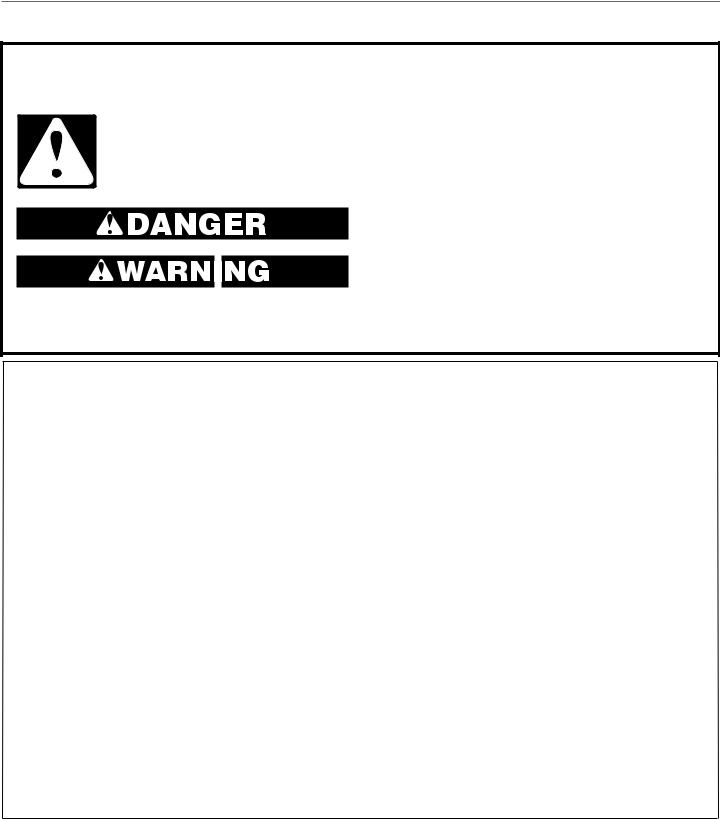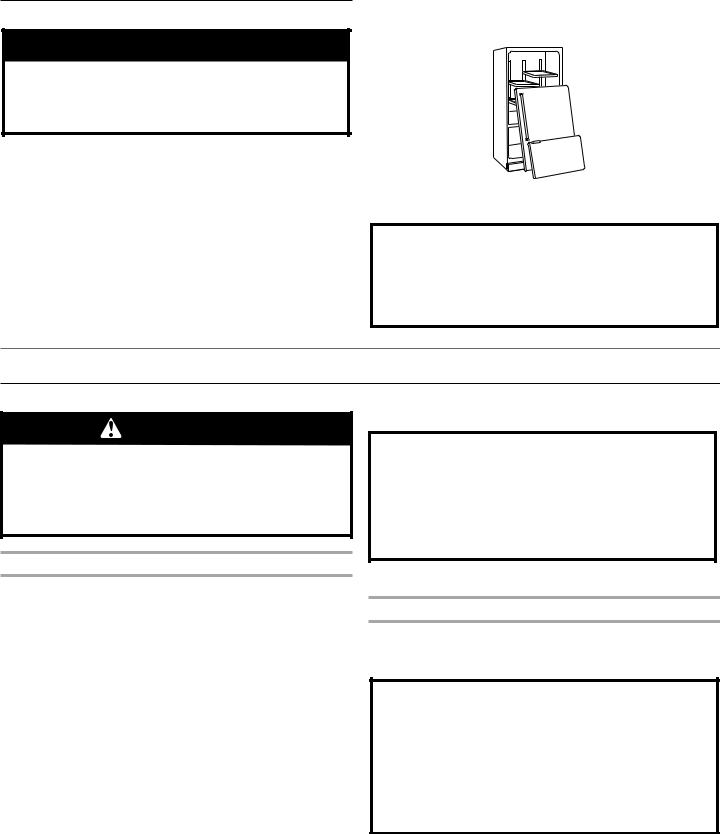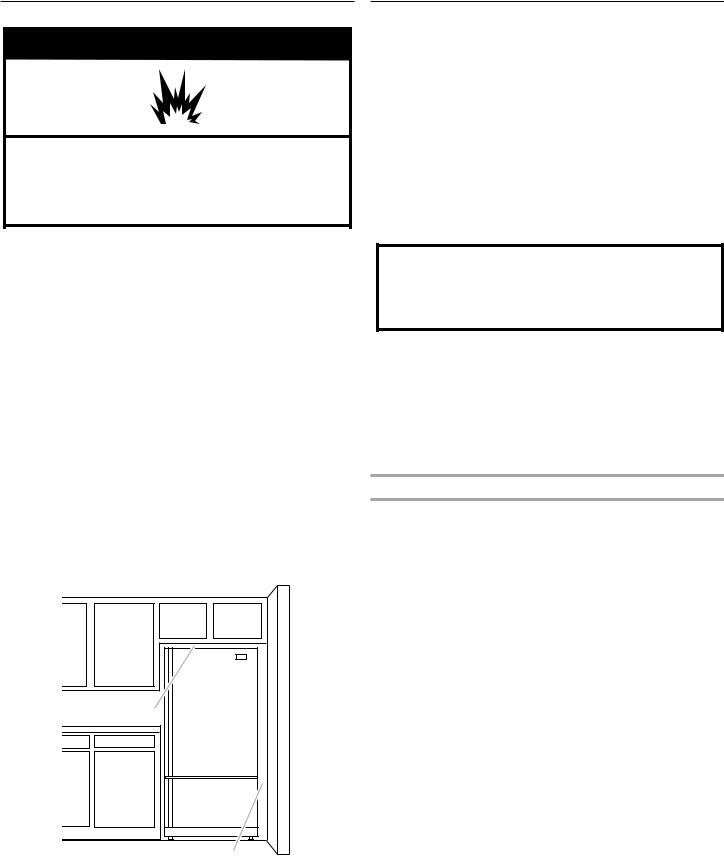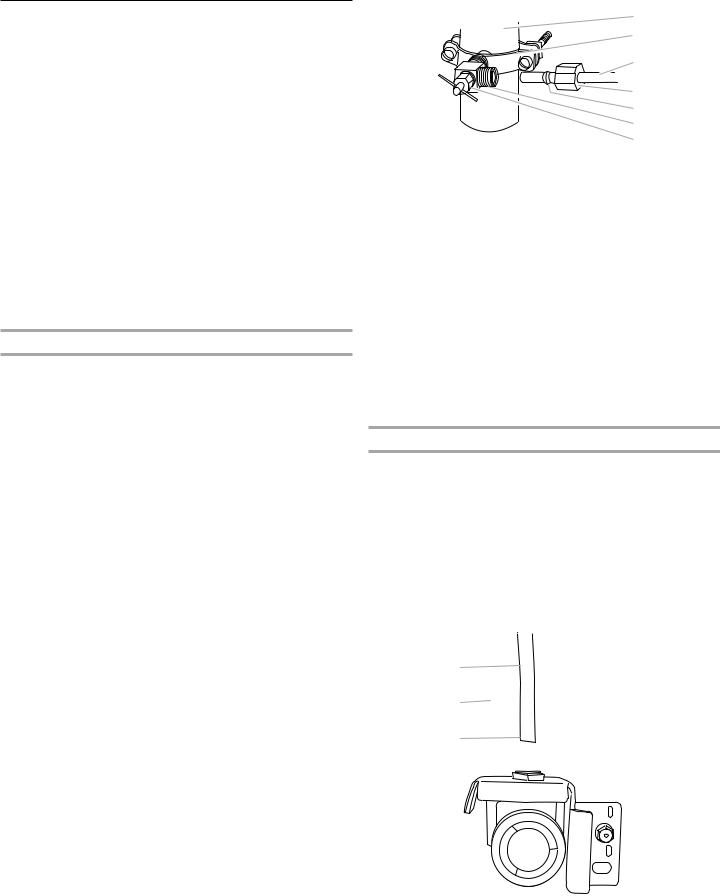Kenmore 596.7931*, 596.7934* Owner's Manual

Use & Care Guide
English |
|
Table of Contents...... |
2 |
Models: 596.7931*, 7934*
Kenmore®
Bottom Mount Refrigerator
* = color number, número de color
P/N W11296629A
Sears Brands Management Corporation
Hoffman Estates, IL 60179 U.S.A.
www.kenmore.com

TABLE OF CONTENTS
WARRANTY............................................................................... |
2 |
REFRIGERATOR SAFETY............................................................ |
3 |
Proper Disposal of Your Old Refrigerator................................. |
4 |
INSTALLATION INSTRUCTIONS................................................. |
4 |
Unpack the Refrigerator................................................................ |
4 |
Location Requirements.................................................................... |
5 |
Water Supply Requirements......................................................... |
5 |
Connect the Water Supply............................................................ |
6 |
Electrical Requirements ................................................................ |
7 |
Refrigerator Door(s) and Drawer................................................. |
8 |
Door Closing and Door Alignment............................................ |
12 |
REFRIGERATOR USE................................................................ |
12 |
Using the Controls......................................................................... |
12 |
REFRIGERATOR FEATURES...................................................... |
13 |
Refrigerator Shelves.................................................................... |
13 |
Crisper and Crisper Cover......................................................... |
13 |
Crisper Humidity Control............................................................ |
14 |
Snack Drawer............................................................................... |
14 |
FREEZER FEATURES................................................................. |
14 |
Freezer Door Shelf |
|
(on some models).......................................................................... |
14 |
DOOR FEATURES.................................................................... |
14 |
Dairy Center................................................................................. |
14 |
Door Bins........................................................................................ |
15 |
Full-Width Door Shelf ................................................................. |
15 |
Ice Maker(on some models)........................................................ |
15 |
REFRIGERATOR CARE............................................................. |
15 |
Cleaning......................................................................................... |
15 |
Changing the Light Bulb.............................................................. |
16 |
Power Interruptions...................................................................... |
16 |
Vacation and Moving Care........................................................ |
16 |
TROUBLESHOOTING............................................................... |
17 |
Refrigerator Operation............................................................... |
17 |
Temperature and Moisture......................................................... |
17 |
Ice and Water.............................................................................. |
17 |
ACCESSORIES.......................................................................... |
18 |
SERVICE NUMBERS................................................ |
BACK COVER |
WARRANTY
KENMORE LIMITED WARRANTY
WITH PROOF OF SALE the following warranty coverage applies when this appliance is correctly installed, operated and maintained according to all supplied instructions.
One Year on Appliance
FOR ONE YEAR from the date of sale this appliance is warranted against defects in material or workmanship. A defective appliance will receive free repair or replacement at option of seller.
Lifetime on Storage Bins
FOR AS LONG AS IT IS USED from the date of sale, a free replacement will be supplied for a defective refrigerator or freezer compartment storage bin. If the defect appears within the first year, a new bin will be installed at no charge. If the defect appears after the first year, a new bin will be supplied but not installed at no charge. This Lifetime warranty covers only storage bins, and does not apply to any other related component or mechanism. You are responsible for the labor cost of bin installation after the first year from the date of sale. This warranty coverage applies for only 90 days from the date of sale if the appliance is ever used for other than private household purposes.
For warranty coverage details to obtain free repair or replacement, visit the web page: www.kenmore.com/warranty
All warranty coverage applies for only 90 DAYS from the sale date if this appliance is ever used for other than private household purposes.
This warranty covers ONLY defects in material and workmanship, and will NOT pay for:
1.Expendable items that can wear out from normal use, including but not limited to filters, belts, bags or screw-in base light bulbs.
2.A service technician to clean or maintain this appliance, or to instruct the user in correct appliance installation, operation and maintenance.
3.Service calls to correct appliance installation not performed by Sears authorized service agents, or to repair problems with house fuses, circuit breakers, house wiring, and plumbing or gas supply systems resulting from such installation.
4.Damage to or failure of this appliance resulting from installation not performed by Sears authorized service agents, including installation that was not in accord with electrical, gas or plumbing codes.
5.Damage to or failure of this appliance, including discoloration or surface rust, if it is not correctly operated and maintained according to all supplied instructions.
6.Damage to or failure of this appliance, including discoloration or surface rust, resulting from accident, alteration, abuse, misuse or use for other than its intended purpose.
7.Damage to or failure of this appliance, including discoloration or surface rust, caused by the use of detergents, cleaners, chemicals or utensils other than those recommended in all instructions supplied with the product.
8.Damage to or failure of parts or systems resulting from unauthorized modifications made to this appliance.
9.Service to an appliance if the model and serial plate is missing, altered, or cannot easily be determined to have the appropriate certification logo.
Disclaimer of implied warranties; limitation of remedies
Customer’s sole and exclusive remedy under this limited warranty shall be product repair or replacement as provided herein. Implied warranties, including warranties of merchantability
or fitness for a particular purpose, are limited to one year on the appliance and for as long as used on the storage bins, or the shortest period allowed by law. Seller shall not be liable for incidental or consequential damages. Some states and provinces do not allow the exclusion or limitation of incidental or consequential damages, or limitation on the duration of implied warranties of merchantability or fitness, so these exclusions or limitations may not apply to you.
This warranty applies only while this appliance is used in the United States.
This warranty gives you specific legal rights, and you may also have other rights which vary from state to state.
Sears Brands Management Corporation,
Hoffman Estates, IL 60179
02/18
2

REFRIGERATOR SAFETY
Your safety and the safety of others are very important.
many important safety messages in this manual and on your appliance. Always read and obey all
.
safety alert symbol.
alerts you to potential hazards that can kill or hurt you and others.
messages will follow the safety alert symbol and either the word “DANGER” or
.” These words mean:
You can be killed or seriously injured if you don't immediately follow instructions.
You can be killed or seriously injured if you don't follow instructions.
All safety messages will tell you what the potential hazard is, tell you how to reduce the chance of injury, and tell you what can happen if the instructions are not followed.
IMPORTANT SAFETY INSTRUCTIONS
WARNING: To reduce the risk of fire, electric shock, or injury when using your refrigerator, follow these basic precautions:
■Plug into a grounded (earthed) outlet.
■Do not remove ground prong.
■Do not use an adapter.
■Do not use an extension cord.
■Disconnect power before servicing.
■Replace all parts and panels before operating.
■Remove doors from your old refrigerator.
■Use nonflammable cleaner.
■Do not store or use petrol, flammable liquids or gas in the vicinity of this or other electrical appliances. The fumes can cause fires or explosions.
■Do not store explosive substances such as aerosol cans with a flammable propellant in this refrigerator.
■Do not use or place electrical devices inside the refrigerator compartments if they are not of the type expressly authorized by the manufacture.
■Use two or more people to move and install refrigerator.
■Disconnect power before installing ice maker (on ice maker kit ready models only).
■A qualified service technician must install the water line and ice maker. See installation instruction supplied with
ice maker kit IC13B for complete details.
■Connect to a potable water supply only.
■Use a sturdy glass when dispensing ice (on some models).
■This appliance is not intended for use by persons (including children) with reduced physical, sensory or mental capabilities, or lack of experience and knowledge, unless they have been given supervision or instruction concerning use of the appliance by a person responsible for their safety.
■Children should be supervised to ensure that they do not play with the appliance.
■To avoid the risk of children becoming trapped and suffocating, do not allow them to play or hide inside the refrigerator.
■If the power supply cord is damaged, it must be replaced by the manufacturer or its service agent or a similarly qualified person.
SAVE THESE INSTRUCTIONS
3

Proper Disposal of Your Old Refrigerator
 WARNING
WARNING
Suffocation Hazard Remove doors from your old refrigerator.
Failure to do so can result in death or brain damage.
IMPORTANT: Child entrapment and suffocation are not problems of the past. Junked or abandoned refrigerators are still dangerous, even if they will sit for “just a few days.” If you are getting rid of your old refrigerator, please follow these instructions to help prevent accidents.
Before You Throw Away Your Old Refrigerator or Freezer:
■■Take off the doors.
■■Leave the shelves in place so that children may not easily climb inside.
Important information to know about disposal of refrigerants:
Dispose of refrigerator in accordance with Federal and Local regulations. Refrigerants must be evacuated by a licensed, EPA certified refrigerant technician in accordance with established procedures.
INSTALLATION INSTRUCTIONS
Unpack the Refrigerator
ARNING
Excessive Weight Hazard
Use two or more people to move and install refrigerator.
Failure to do so can result in back or other injury.
Remove the Packaging
When Moving Your Refrigerator:
Your refrigerator is heavy. When moving the refrigerator for cleaning or service, be sure to cover the floor with cardboard or hardboard to avoid floor damage. Always pull the refrigerator straight out when moving it. Do not wiggle or “walk” the refrigerator when trying to move it, as floor damage could occur.
■■ Remove tape and glue residue from surfaces before turning on the refrigerator. Rub a small amount of liquid dish soap over the adhesive with your fingers. Wipe with warm water and dry.
■■ Do not use sharp instruments, rubbing alcohol, flammable fluids, or abrasive cleaners to remove tape or glue. These products can damage the surface of your refrigerator. For more information see the “Refrigerator Safety” section.
■■ Shelves, bins, door shelf rails, and other feature parts may be packaged in the Interior FeaturePak. Follow the instructions contained in the package for proper assembly.
■■ Dispose of/recycle all packaging materials.
Clean Before Using
■■ After you remove all of the packaging materials, clean the inside of your refrigerator before using it. See the cleaning instructions in the “Refrigerator Care” section.
Important information to know about glass shelves and covers:
Do not clean glass shelves or covers with warm water when they are cold. Shelves and covers may break if exposed to sudden temperature changes or impact, such as bumping. Tempered glass is designed to shatter into many small, pebble-size pieces. This is normal. Glass shelves and covers are heavy. Use both hands when removing them to avoid dropping.
4

Location Requirements
 WARNING
WARNING
Explosion Hazard
Keep flammable materials and vapors, such as gasoline, away from refrigerator.
Failure to do so can result in death, explosion, or fire.
IMPORTANT: TThis appliances is intended to used in household and similar applications such as:
■■ Staff kitchen areas in shops, office and other working environments;
■■ Farm houses and by clients in hotels, motels and other residential type environments;
■■ Bed and breakfast type environments;
■■ Catering and similar non-retail applications.
To ensure proper ventilation for your refrigerator, allow for 1/2" (1.25 cm) of space on each side and at the top. Allow for 1" (2.54 cm) of space behind the refrigerator. If your refrigerator has an ice maker, allow extra space at the back for the water line connections. When installing your refrigerator next to a fixed wall, leave 33⁄4" (9.5 cm) minimum on the hinge side (some models require more) to allow for the door to swing open.
NOTE: This refrigerator is intended for use in a location where the temperature ranges from a minimum of 55°F (13°C) to a maximum of 110°F (43°C). The preferred room temperature range for optimum performance, which reduces electricity usage and provides superior cooling, is between 60°F (15°C) and 90°F (32°C).
It is recommended that you do not install the refrigerator near a heat source, such as an oven or radiator.
¹⁄ " (1.25 cm)
3³⁄ " (9.5 cm)
Water Supply Requirements
Gather the required tools and parts before starting installation. Read and follow the instructions provided with any tools listed here.
TOOLS NEEDED:
■■ Flat-blade screwdriver
■■ 7/16" and 1/2" Open-end or two adjustable wrenches ■■ 1/4" Nut driver
■■ 1/4" Drill bit
■■ Cordless drill
IMPORTANT:
■■ Connect to a potable water supply only.
Do not use with water that is microbiologically unsafe or of unknown quality without adequate disinfection before or after the system. Systems certified for cyst reduction may be used on disinfected waters that may contain filterable cysts.
■■ All installations must meet local plumbing code requirements.
■■ Do not use a piercing-type or 3/16" (4.76 mm) saddle valve which reduces water flow and clogs more easily.
■■ Use copper tubing and check for leaks. Install copper tubing only in areas where the household temperatures will remain above freezing.
■■ For models with water filters, the disposable water filter should be replaced at least every 6 months.
Water Pressure
A cold water supply with water pressure of between 35 and 120 psi (241 and 827 kPa) is required to operate the water dispenser and ice maker. If you have questions about your water pressure, call a licensed, qualified plumber.
Reverse Osmosis Water Supply
IMPORTANT: The pressure of the water supply coming out of a reverse osmosis system going to the water inlet valve of the refrigerator needs to be between 35 and 120 psi (241 and 827 kPa).
If a reverse osmosis water filtration system is connected to your cold water supply, the water pressure to the reverse osmosis system needs to be a minimum of 40 to 60 psi (276 to 414 kPa).
If the water pressure to the reverse osmosis system is less than 40 to 60 psi (276 to 414 kPa):
■■ Check to see whether the sediment filter in the reverse osmosis system is blocked. Replace the filter if necessary.
■■ Allow the storage tank on the reverse osmosis system to refill after heavy usage.
■■ If your refrigerator has a water filter, it may further reduce the water pressure when used in conjunction with a reverse osmosis system. Remove the water filter. See “Water Filtration System.”
If you have questions about your water pressure, call a licensed, qualified plumber.
5

Connect the Water Supply
Read all directions before you begin.
IMPORTANT:
■■ Plumbing shall be installed in accordance with the International Plumbing Code and any local codes and ordinances.
■■ The gray water tubing on the back of the refrigerator (which is used to connect to the household water line) is a PEX (cross linked polyethylene) tube. Copper and PEX tubing connections from the household water line to the refrigerator are acceptable, and will help avoid off taste or odor in your ice or water. Check for leaks.
If PEX tubing is used instead of copper, we recommend the following part numbers:
W10505928RP (7 ft [2.14 m] jacketed PEX), 8212547RP (5 ft [1.52 m] PEX), or W10267701RP (25 ft [7.62 m] PEX).
■■ Install tubing only in areas where temperatures will remain above freezing.
■■ If you turn on the refrigerator before the water line is connected, turn off the ice maker to avoid excessive noise or damage to the water valve.
Connect to Water Line
1.Unplug refrigerator or disconnect power.
2.Turn OFF main water supply. Turn ON nearest faucet long enough to clear line of water.
3.Find a 1/2" to 1¹⁄4" (12.7 mm to 31.8 mm) vertical cold water pipe near the refrigerator.
IMPORTANT:
■■ Make sure it is a cold water pipe.
■■ Horizontal pipe will work, but the following procedure must be followed: Drill on the top side of the pipe, not the bottom. This will help keep water away from the drill. This also keeps normal sediment from collecting in the valve.
4.Determine the length of copper tubing you need. Measure from the connection on the lower right rear of the refrigerator to the water pipe. Add 7 ft (2.1 m) to allow for cleaning. Use 1/4"
(6.35 mm) O.D. (outside diameter) copper tubing. Be sure both ends of copper tubing are cut square.
5.Using a cordless drill, drill a 1/4" hole in the cold water pipe you have selected.
|
A |
|
B |
|
C |
|
D |
|
E |
|
F |
|
G |
A. Cold water pipe |
E. Compression sleeve |
B. Pipe clamp |
F. Shutoff valve |
C. Copper tubing |
G. Packing nut |
D.Compression nut
6.Fasten the shutoff valve to the cold water pipe with the pipe clamp. Be sure the outlet end is solidly in the 1/4" drilled hole in the water pipe and that the washer is under the pipe clamp.
Tighten the packing nut. Tighten the pipe clamp screws slowly and evenly so the washer makes a watertight seal. Do not overtighten.
7.Slip the compression sleeve and compression nut on the copper tubing as shown. Insert the end of the tubing into the outlet end squarely as far as it will go. Screw compression nut onto outlet end with adjustable wrench. Do not overtighten or you may crush the copper tubing.
8.Place the free end of the tubing in a container or sink, and turn
ON the main water supply. Flush the tubing until water is clear. Turn OFF the shutoff valve on the water pipe.
Connect to Refrigerator
Depending on your model, the water line may come down from the top or up from the bottom. Follow the connection instructions for your model.
Style 1
1.Remove plastic cap from water valve inlet port. Attach the copper tube to the valve inlet using a compression nut and sleeve as shown. Tighten the compression nut. Do not over tighten. Confirm copper tubing is secure by pulling on copper tubing.
2.Create a service loop with the copper tubing. Avoid kinks when coiling the copper tubing. Secure copper tubing to refrigerator cabinet with a “P” clamp.
A
B
C
D
A. Copper tubing |
C. Compression nut |
B. “P” clamp |
D. Compression sleeve |
6
